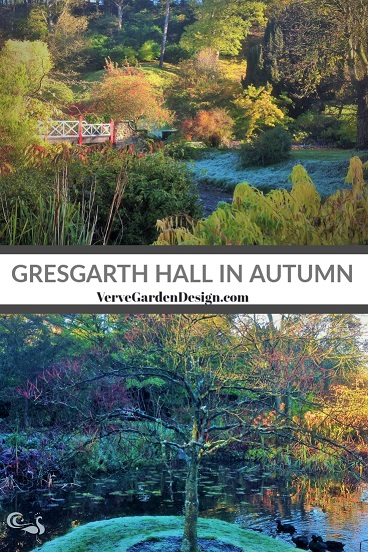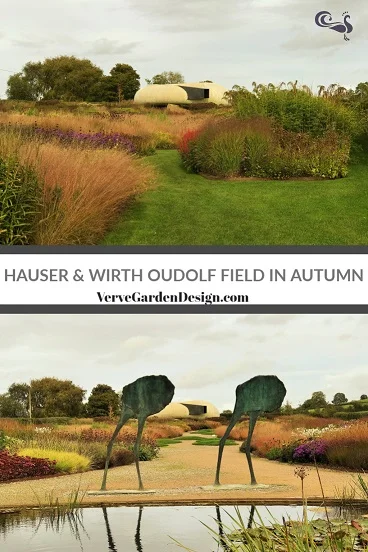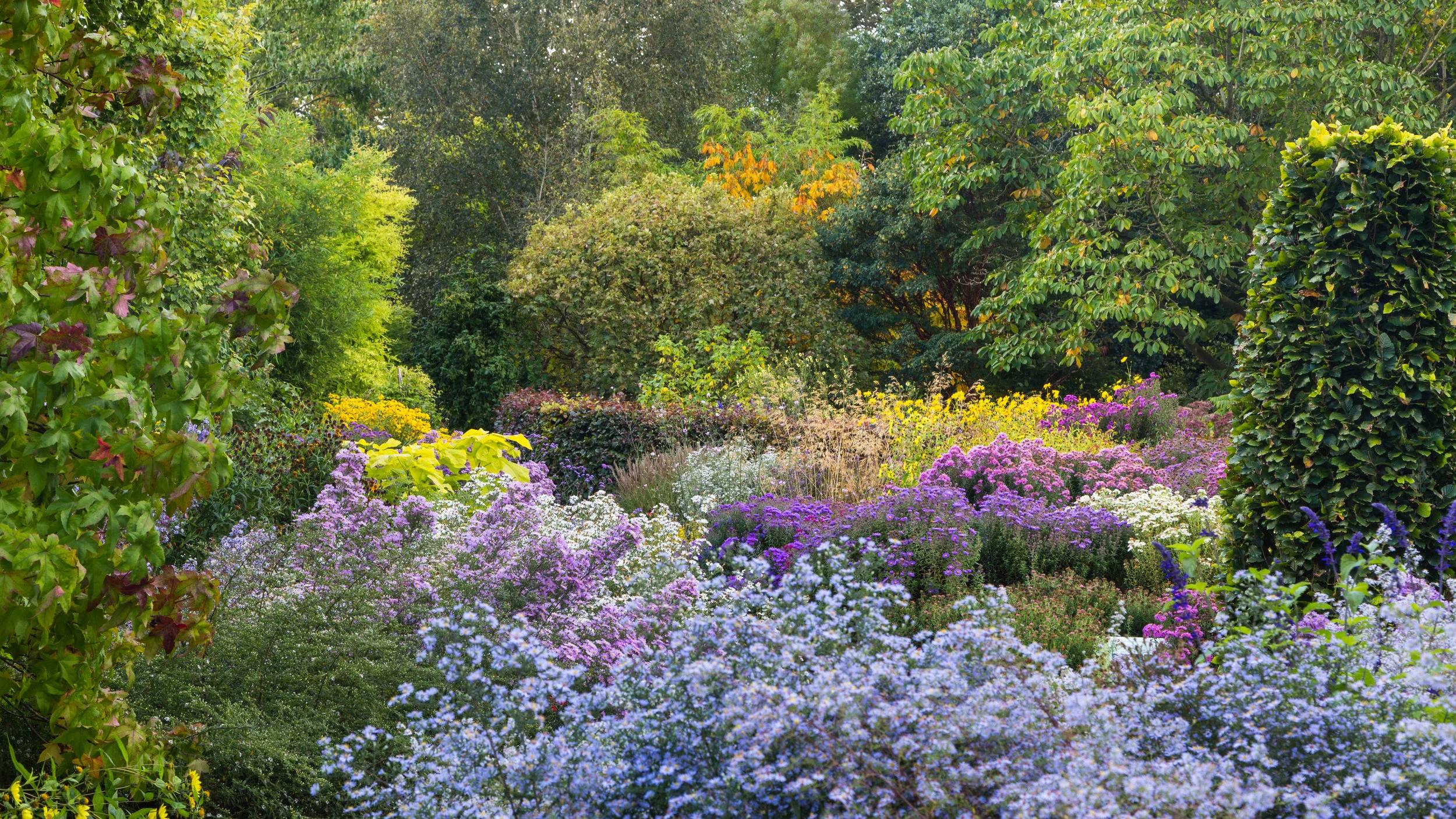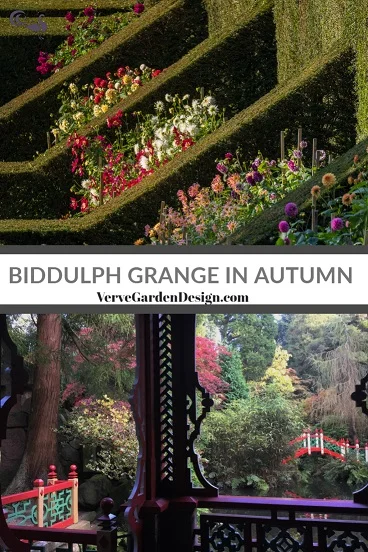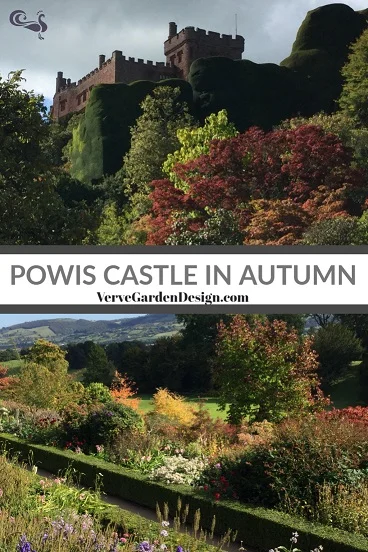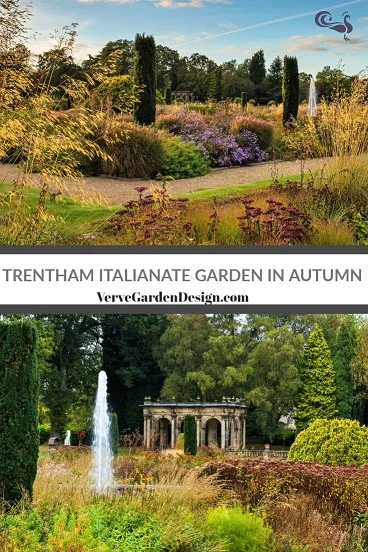Our Favourite Autumn Gardens To Visit For Design Inspiration
This month we take you on a tour of some of the amazing autumn gardens we have visited. It’s part of our mission to get everyone outdoors and exploring more. You might not be able to visit the gardens we highlight, but check out where you could go nearer to you. Otherwise, enjoy the read and our tips for design inspiration that you could use at home.
Colourful Gardens To Visit For Design Inspiration in September
The 9 Very Best Gardens To Visit in August
The 7 Best English Gardens To Visit For Meadow-Style Planting
In no particular order:
1. Gresgarth Hall For Outstanding Trees and Shrubs
Stunning combination of autumn shrubs and trees reflected in the lake at Gresgarth Hall. Image: Chris Denning/ Verve Garden Design.
Gresgarth Hall Garden in Autumn. Planting Design: Arabella Lennox-Boyd. Image: Lorraine Young/ Verve Garden Design.
Arabella Lennox-Boyd knows a thing or two about plants. She has created an incredible garden around her home in Lancashire.
Earlier in the season, Gresgarth has plenty of colourful perennials to delight (see our August Garden Visit blog). In October and November, however, the trees and shrubs take centre stage.
It is actually rather refreshing to see an internationally-renowned designer not shy away from woody plants, as many other modern designers have done. However, there is absolutely nothing old-fashioned about Arabella’s garden. She has sought out shrubs that give the variety in texture, shape and colour you would expect of a floriferous herbaceous border in high summer. Her secret is to seek out the very best varieties to create the effects she wants- no car park shrubs allowed in this part of Lancashire!
Although Gresgarth is much larger than most gardens, it is planted in small, intimate areas so it is easy to see how you could use similar trees and shrubs in a small garden at home. It is only open one day a month so do check the website before you set out.
DESIGN TAKEAWAYS
When we buy a small shrub in a pot, it’s shape often bears no relation to its final form. Do your research before you buy and choose a shrub or tree whose shape and size you know will suit your garden in a few years time (see Plant Shopping For Newbie Gardeners | How Not To Waste Your Time and Money),
Small trees can make an amazing focal point in a small garden so long as you choose the variety carefully- we should be less wary of using them. Just one cherry or Acer can make a magnificent feature in autumn, as well as spring.
One of the reasons we think of shrub gardens as old-fashioned is that they often contain one each of many varieties. Too many shapes, sizes and colours often do not harmonise well together. At Gresgarth, Arabella has repeated smaller evergreen shrubs and the lovely weeping willow-leaved pear (Pyrus salicifolia 'Pendula’ ). Even three of the same plant can give rhythm to a border and make it more cohesive- see more on this in 'Design Better Garden Borders With Repetition'.
2. Oudolf Field, Hauser and Wirth, Somerset
Billowing mounds of grass following the curve of a path encourage you to walk along it. Designer: Piet Oudolf at Hauser and Worth. Image: Chris Denning/Verve Garden Design.
Island Beds in the Hauser & Wirth Prairie Garden in Autumn. Designer: Piet Oudolf. Image: Chris Denning/ Verve Garden Design.
In complete contrast to Gresgarth, the field-turned garden at the Hauser and Wirth Art Gallery is comprised entirely of perennial flowers and grasses. The entire planted composition has been painstakingly designed by Dutch plant designer, Piet Oudolf. Rather than enclosing itself from the surrounding agricultural countryside as at Gresgarth, the Oudolf Field embraces it. The flat, relatively low, forms of the plants form a mass of pretty-much one height, creating a much more open effect. Cleverly, however, since the plant height averages around 1 m, when you walk between the kidney-bean shaped island beds you do feel immersed within the planting. The movement of the grasses and the detail of the decaying seed-heads keeps your focus firmly on the plants as you walk along the grass paths.
At the far end of the field, lies a pavilion from which you can look down on the whole field. The Radić Pavilion, designed by Chilean architect Smiljan Radić, was originally installed at the Serpentine Gallery in London. From above there is a real sense of how the planting is an art form befitting of it’s gallery home.
Around the front and rear of the gallery are some amazing outdoor sculptures. and the gallery itself is very worth a wander around. The very hip Roth Bar and Grill does pretty good coffee and seasonal food, while the book shop has a choice selection of design-focused garden books.
For more Piet Oudolf planting see our features of Scampston Hall in Yorkshire and Trentham Gardens.
design takeaways
Flower beds do not have to be rectangular and at the boundaries of your garden. Even in a smaller space, two island beds with a meandering path in-between could create a wonderful space to showcase some really interesting plant combinations.
In planting schemes where everything is one one height, repetition, texture and colour are key to creating interest.
3. The Picton Garden, Warwickshire
Asters and Autumn Colour in The Picton Garden. Image: Chris Denning/ Verve Garden Design.
The Picton Garden in Autumn. Image: Chris Denning/ Verve Garden Design.
We challenge you to find a garden with more flowers in Autumn than the Picton Garden in Worstercershire. Set up as an extension to the adjacent Old Court Nurseries, the Picton Garden is famed for it’s National Collection of Asters (Michaelmas Daisies). I love really good nurseries which have plants growing in a garden. It is so much easier to envisage how tall they will grow and their final shape than if you only see them in a small pot.
Asters are characterised by masses of small, star-like flowers that bloom in early-mid October and often flower well into November. They provide a great source of nectar for bees and butterflies and make good cut flowers.
There are huge borders showcasing many of the main types of Aster found in gardens. Curvy, island beds house New England Asters (Symphyotrichum novi-angliae) in various shades of purple and blue . These are species hybrids, with many types originally developed at Old Court in the first half of the 20th Century. Many are around 1-2m tall with tall. woody stems. This makes them ideal for the back of larger borders in prairie-style plantings and in windy locations.
In contrast, many of the bushier New York asters (Symphyotrichum novi-belgii) are showcased in mixed borders with grasses and other late flowering perennials. There are some spectacular and inspiring combinations showcasing the asters in many shades of pink, purple, blue and white. At around 1 m tall, these are more suitable for smaller gardens.
There are two raised bed areas not to miss. One houses a frothy collection of lower-growing Aster amellus and other small-flowered hybrids. You can’t miss the other one with a genius pop of giant red-hot pokers (Kniphophia rooperi) amidst an architectural conifer collection and some front-of-the-border short Michaelmas daisies.
All this amongst a lovely backdrop of beautifully-coloured autumn trees and shrubs. You won’t find anywhere else like it!
design takeaways:
Asters do need at least half sun to perform well but they are happy in most soil types and so long as they have some moisture they will perform their little hearts out for weeks. Many are prone to getting mildew infections on their leaves, especially if planted very closely to their neighbours. Some hybrids have good mildew resistance but otherwise make sure you plant them behind something else if the stems will be in full view. I can’t imagine my October/November garden without them. Divide the clumps every 3 years to keep the clumps flowering well but also to stop them spreading too widely in richer soils.
Espalier apples in front of the Long Range Glasshouse at Clumber Park. Image: Chris Denning/ Verve Garden Design.
We include the four acre Walled Kitchen Garden at Clumber Park in Nottinghamshire, not for it’s wow factor planting in Autumn, but for it’s simple, structural elegance.
There are some beautifully-architectural, espalier fruit trees that you can really appreciate at this time of year when the garden is less lush.
When all of the exuberant summer veggies have past and the huge National Collection of rhubarb is resting for the year, you really notice the magnificence of the Long Range glasshouse. As wide as the whole walled garden (130m/450m long), the longest glasshouse in a National Trust Garden originally grew warm climate fruits for the 7th Duke of Newcastle. The glasshouse is still beautifully planted with fruits, vegetables, palms and flowers. However, what we really love to see is the potting shed museum with some wonderful stories of how the Victorian gardeners produced exotics for the table with some ingeniously-simple implements.
Outside the glasshouse, the orchard has more than 70 local varieties of apple. There are usually some for sale in the little stall by the Walled Kitchen Garden entrance. You might not know that the well-loved Bramley cooking apple originated in nearby Southwell. Here a young girl called Mary Ann Brailsford grew the first tree from a pip in 1809. Local nurseryman, Henry Merryweather, propagated the tree when it later belonged to Mathew Bramley, the local butcher. There are now more than 300 Bramley growers in England and a £50 million industry from that original Nottinghamshire tree!
design takeaways:
Colourful flowers offer instant gratification in gardens, but anchoring some longer-lived details into your design is crucial for making your garden work for you year round. You might not have a historical glasshouse to work with (or a National Trust budget). Invest a little more in your shed than if it were purely functional and paint it a sympathetic colour rather than using standard orange shed treatment. If you are going to buy a greenhouse, make sure the frame will enhance the garden and work with it. If you have even less space and budget, make some architectural cold frames and paint them in a gorgeous colour to make a real feature.
Espalier pruning of fruit trees has been popular in Europe as a space saving-means of fruit production since the 16th and 17th centuries. Essentially, 1 year old seedlings are trained so that their branches grow horizontally. Often, you find espaliers trained against a wall. However, they make spectacular tools for delineating different areas in a small garden. They give the impression of a boundary but let plenty of light through and so don’t make the divided space seem too small.
Don’t forget about going into the garden as soon as summer ends. Take the time to walk around with a warm cup of coffee in your hands and enjoy the detail of things you would not normally notice. Breathe it in and relax, that’s what it’s all about.
Yew Hedge Parterres and Autumn Trees at Biddulph Grange. Image: Chris Denning/ Verve Garden Design.
The Dahlia Walk and China Pavilion at Biddulph Grange. Image: Chris Denning/ Verve Garden Design.
Biddulph Grange is a wacky, outlandish remnant of Victorian travel fever. It was established by owner James Bateman together with his artist friend, Edward Cooke.
The whole area is laid out in a series of gardens of very different character and influence. Generally, you don’t see one area from another and there are lots of secret little paths, tunnels and stepping stones leading you between them to increase the air of mystery. The garden is laid out so that the visitor is led from one area to another in a journey of discovery and exploration. Paths, steps and tunnels lead from one to area to another resulting in an intriguing journey of discovery.
There is so much structure in the gardens at Biddulph Grange that the gardens make an enjoyable visit anytime. In Autumn, however, our favourite areas are:
The trees starting to colour up around the lake. Bateman sponsored plant hunters to collect plants from around the globe for his garden and so there are some wonderful specimens.
The amazing topiary hedge framework in the Yew Parterres that really comes alive in the autumn light. So long as you get there before the frosts, the exuberant colour of the Dahlia walk below is still quite a sight in October.
The Acers and soft textural foliage around the China Pavilion. The vermillion red of the pavilion and bridge in the China garden seem a bit harsh for the planting in summer light, but by October they make a stunning contrast. This part of the garden is very popular and gets busy, so go early or late if, like me, you want to linger a while.
DESIGN TAKEAWAYS:
Consider using a hedge in your garden to divide two areas.
If you have an expanse of lawn, position a shrub, small tree or other vertical object to cast a partial shadow in autumn. The contrast between the light and shadow can be magical.
Before you choose a paint colour to use in your garden, consider how it will look as the light changes at different times of the year.
Trees in Autumn Colour at Powis Castle. Image: Chris Denning/ Verve Garden Design.
Powis Castle Garden Terraces in Autumn Image: Lorraine Young/ Verve Garden Design.
We featured the incredible hot colours found in the herbaceous upper terraces at Powis Castle in our September article. From October, however, it is the trees of the bank and parkland below that keep this garden on our list this month. If you can’t make it to New England in the Fall, come to Wales!
DESIGN TAKEAWAYS:
If you want to get the autumn colour from your Japanese maples (Acers) that you saw on the plant label or in that gorgeous picture online, a couple of things help- they need some sun and they need plenty of water in summer.
Different types of trees and shrubs show their autumn colours over several weeks between the end of September to mid November. One specimen with fabulous orange or yellow leaves can make a residential-sized garden, but how much better would it be if you spaced out three specimens to give you gorgeous autumn colour over the whole period? Talk to local nurseries- they will sort you out.
The Italianate Garden Looking towards Trentham Church. Designer: Ton-Stuart-Smith. Image: Chris Denning/ Verve Garden Design.
Grasses and Columnar Yew Trees in the Trentham Italianate Garden by Tom Stuart-Smith. Image: Chris Denning/ Verve Garden Design.
If you have been following our blog you will know by now that we love Trentham Gardens in Staffordshire for its visionary embracing of the work of some of the very best contemporary garden designers. We have previously featured the prairie areas of Piet Oudolf and the meadows designed by Nigel Dunnett. In Autumn the more formal Italianate Garden centrepiece of the estate is what draws us back year after year.
When home to the second Duke of Sutherland in the 19th century, a grand Italianate style terrace was installed at Trentham. It was designed by the Victorian architect Sir Charles Barry who installed Italianate Renaissance architecture and gardens across England. Typical of this style the two terraces were designed using formal lines and impressive fountains.
There are two terraces. The vast Lower Terrace leads down to the Capability Brown lake, while the smaller, Upper Terrace connects to Trentham Church. These Terraces at Trentham were pioneering in developing the planting styles that define English gardens. The Head Gardener at the time, George Fleming, employed seasonal bedding schemes and loved colour-themed borders with ribbons of plants intermingled.
Unfortunately, the house at Trentham was demolished after the estate suffered from industrial pollution in the River Trent. The garden was neglected for over 100 years until Garden Manager, Michael Walker, brought in designer, Tom Stuart-Smith, in 2003. In the revamp, the garden has stayed true to the Italianate style using wide, linear paths and a central avenue lined with topiary trees in painted wooden planters. Restored, circular stone raised pools with tall needles of fountains draw your eye into the garden from the periphery and invite you to wonder at them, as would have been the case in Victorian times. More formality has been introduced by using clipped columns of yew as a nod to a signature Stuart-Smith feature. What is really wonderful about the Italianate gardens now though, is that Stuart-Smith has not emulated the original planting styles. Instead he has celebrated the pioneering tradition of Victorian plantsman George Fleming by using his own modern ideas. Well-behave perennials that don’t need staking or regular watering intermingle with grasses in drifts and blocks to create a hugely complex and accomplished planting scheme.
So why do we love October to see these Terraces (honestly- they look great all year). We love the late afternoon sun back-lighting the fan-shaped Stipa gigantea grasses and mimicking the shape of the fountains. We love the muted colours of the Sedum and the Asters and we love how the planting enhances the remaining walls of the surviving architecture so well. Finally, we love that it is open later in the evening than most gardens, so you can really enjoy the best of the late afternoon light.
Design Takeaways
Repetition. We have covered this before in Design Better Garden Borders Using Repetition but it really makes all the difference in gardens of any size. Although there are a huge variety of plants in this garden, some are repeated throughout to give it coherence and flow. Mound-shaped plants are also used repeatedly to let the eye gently bounce between the taller grasses.
Light. Grasses look especially beautiful when lit by autumn light. Place them where they will be back lit or highlighted at the time of day you use your garden the most.
Best Gardens To Visit For Autumn Colour. Image: Chris Denning/ Verve Garden Design.
Which of our chosen October Gardens is your favourite?
Where do you love to visit near you in October?
Let Us Know in the Comments Below to share the love!

